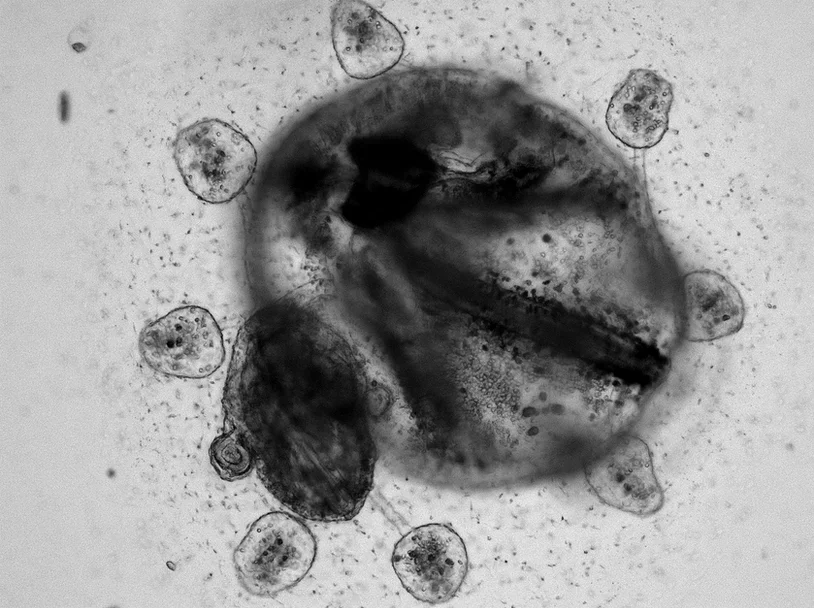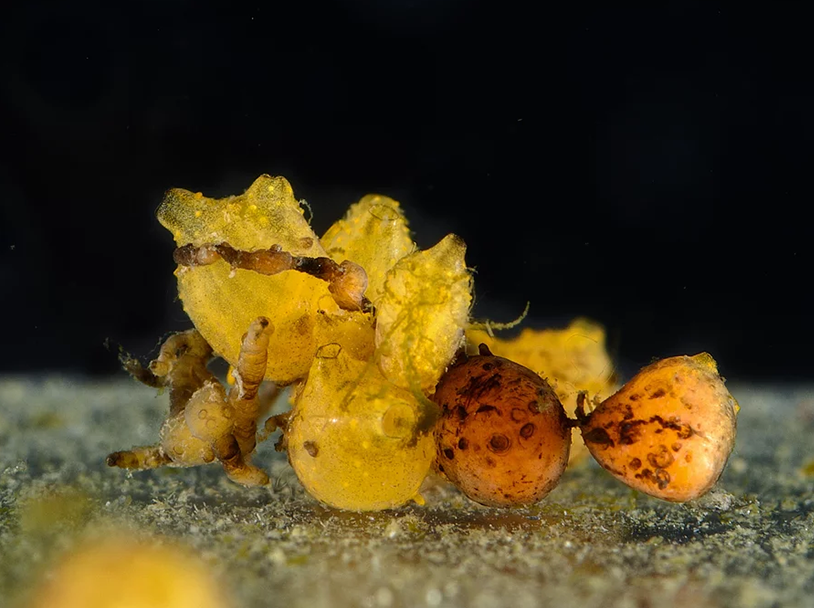« There are colonies of pelagic tunicates which have taken shape like the finger of a glove. Each member of the colony is an individual animal, but the colony is another individual animal, not at all like the sum of its individuals… So a man of individualistic reason, if he must ask, ‘Which is the animal, the colony or the individual?’ must abandon his particular kind of reason and say, ‘Why, it’s two animals and they aren’t alike in any more than the cells of my body are like me. I am much more than the sum of my cells, and, for all I know, they are much more than the division of me.' » John Steinbeck, The Log from the Sea of Cortez



Understanding the ability to regenerate organs and tissues is the long-term goal of research into stem cell biology and regenerative medicine. This is particularly interesting in light of the lack of conservation of regenerative capabilities during evolution: a salamander can regenerate an amputated limb but a human cannot. However, despite the conservation of some molecular mechanisms, it is now clear that different taxa adopt different molecular and cellular strategies to rebuild their lost structures and the evidence against a universal and conserved program behind regeneration is compelling. The term regeneration is in fact a label attached to many different molecular and cellular phenomena that cover an extensive and heterogeneous array of processes present in metazoans and have the common result of restoring, partially or totally, a lost body part.
To better understand the cellular and molecular mechanisms of regeneration and at the same time to attempt to track their evolution. We propose first (1) to focus in conserved chronological steps that occur during the restoration of a particular structure, particularly on the nature and mobilization of the cell precursors; (2) to compare them in a restrained taxonomical clade and (3) to include in the comparison species with different or no regenerative capabilities.



Tunicates (Phylum Chordata) encompass a large group of ubiquitous and diverse animals that occupy a wide variety of marine habitats and ecosystems around the world. They are also the closest relative to vertebrates that have extraordinary abilities to regenerate their whole body. For instance, within the family of Styelidae, it possible to find solitary species that reproduce strictly sexually and have limited regenerative capabilities, and colonial species, which can reproduce both sexually and asexually via diverse modes of budding and also evolved tremendous ability to regenerate after injury. Budding and regeneration are two processes of “non-embryonic development” (NED) that involve common cellular and molecular mechanisms.
The discipline of evolutionary developmental biology (evo‐devo) is based on comparisons of developmental mechanisms among species to explore the phenotypic changes during evolution. Tunicates provide different levels in which these comparisons can be explored:
NED vs embryogenesis
Despite being extremely different, in many tunicate budding and sexual development lead to similar post-metamorphic body plans. Then, embryogenesis, metamorphoses, and non-embryonic development can be analyzed side‐by‐side in the same species to explore how homologous features can be obtained following completely different developmental mechanisms.
NED vs NED
NED modes are diverse among tunicate species, in terms of the nature of triggering cells and tissues and early ontogenesis. The comparisons between similar and different NED modes in diverse species, or even different NED modes in the same species may illuminate deep homologies in budding mechanisms.
NED vs No NED
The multiple gains and losses of budding in tunicates provide an opportunity to explore the mechanisms underlying the acquisition of NED.
Two major challenges of regenerative biology concern the rebuilding of not only simple tissues but also complex structures (i.e. with multiple cell and tissue types, axes organization, or sophisticated morphologies) and the lack of conservation of such regenerative capabilities in mammals and particularly in human. The combination of transcriptomic and functional approaches in comparing NED and an evolutionary understanding of asexual development and whole-body regeneration in the sister group of vertebrates has the potential to unravel the bases of developmental plasticity of stem cell and cell de/transdifferentiation in our own phylum.
In tunicates, the capacity of budding, and therefore re-growing of clonal copies of the original individual (zooid), occurs through different mechanisms of interaction between non-homologous epithelial tissues and/or putative stem cells circulating in the bloodstream…
In order to better test the function of specific genes, and to follow the dynamic of the cells involved in NED we aim to establish transgenic colonies of B. schlosseri, a technical challenge that will open new avenues for functional study and high-resolution live imaging of budding…
The aim of this project is to uncover the molecular mechanisms by which circulating mesenchymal cells are able to reconstruct a new individual…
o highlight genomic signatures linked to NED and to highlight other genotype-phenotype convergent associations related to characters linked to the capacity of undergoing NED, we are sequencing and comparing the genomes of four species of Styelid, two colonials (Botryllus schlosseri and Polyandrocarpa zorritensis) and two solitaries (Dendrodoa grossularia and Styela plicata). As an offshoot, we may be able to collect insights on the possible effects of asexual propagation on evolution of genome architecture, for example due to heritable mutations of the somatic pluripotent stem cells…
Horizontal gene transfer (HGT) is the acquisition of genetic material from non-parent organisms of different species, by opposition with vertical gene transfer where the genetic material is inherited from the parents. While this process is widely described in prokaryotes where it has been shown to accelerate their evolution, the impact of HGT on the evolution of eukaryotes, and particularly on metazoans, remains a relatively unexplored field of research. In collaboration with the team of Dr. Simon Blanchoud (University of Fribourg, Switzerland) we began to investigate the extent and the nature of HGTs in Tunicates…
Funded by the Advanced Research Program at the Université Côte d’Azur, the project ‘ If we were to look at regeneration with a different eye’ has been initiated as an artistic-scientific collaboration with the artist Irene Kopelman and the Röttinger (IRCAN – UCA, CNRS, INSERM), and is driven by Irene long-term engagement with scientific research which underlies her artistic practice…
“Ascidians are remarkable for the conservation of their embryonic development during million years of evolution. Thaliaceans are embedded within the latter clade and offer a unique opportunity to study how developmental strategies evolved following the pelagic transition. In collaboration with Patrick Lemaire and Jacques Piette (CRBM, Université de Montpellier) we use modern microscopic and molecular biology techniques to follow the destiny of early embryonic blastomeres and the progeny of somatic follicle cells, called calymmocytes, during the embryogenesis of two divergent salp species, Salpa fusiformis and Thalia democratica.”

Laboratoire de Biologie du développement UMR 7009
Cette UE se déroule sur 2 semaines et a lieu au laboratoire de Biologie du Développement de Villefranche -sur-Mer (LBDV). Elle inclut l’examen de l’UE d’analyse scientifique (5V089) suivie par les étudiants de la spécialité de Biologie du Développement.
Durant la 1ère semaine, les étudiants participent à des ateliers et des rencontres avec les chercheurs du laboratoire.
Durant la 2ème semaine, les étudiants sont répartis dans les équipes pour y réaliser un mini projet qu’ils présentent le dernier jour du cours. Le cours est donné en anglais pour tout ou partie.
Modalités d’évaluation
Présentation orale du mini-projet (binôme, 100 %)
UE en anglais (partiellement ou totalement)
Master BMC, S3, 6 ECTS
Code UE: 5V200
Responsable de l’UE: Carine BARREAU (MCU): carine.barreau [at] obs-vlfr.fr
Cette UE permet aux étudiants de 1ère année de Master de passer 2 semaines à l’Observatoire Océanologique de Villefranche-sur-Mer. Le cours est obligatoire pour les étudiants du Master Biologie Intégrative, parcours Biologie et Bioressources Marines (BBMA) tandis qu’il peut être choisi en option par les étudiants du Master Biologie Moléculaire et Cellulaire (BMC). Les étudiants participent à des ateliers de présentation des organismes marins utilisés par les équipes de recherche du laboratoire (LBDV) et apprennent à les manipuler au cours de travaux pratiques dont les thématiques vont de la Biologie du Développement fondamentale à la toxicologie appliquée.
Modalités d’évaluation
Analyse d’article et présentation orale (50%)
Compte-rendu écrit de TP (50%)
UE partiellement en anglais
Master BIP, S2, 6 ECTS
Code UE: 4B022 (ouverte au Master BMC)
Responsable de l’UE: Carine BARREAU (MCU): carine.barreau [at] obs-vlfr.fr
Cette UE complémentaire se déroule sur 2 semaines et permet aux étudiants de découvrir les différents aspects (métiers & recherche) de l’Observatoire Océanologique de Villefranche-sur-Mer (OOV). Ateliers et journal clubs sont organisés afin que les étudiants mettent en pratique leurs connaissances théoriques en biologie et développent leur capacité de communication scientifique en français et en anglais.